
K stands for Kharif while R stands for Rabi. Negative values indicate loss/decline, while positive ones show gain/rise.
How would crops be affected due to decline in the number of wells ?
Due to decline in the number of wells, the area under irrigation will decrease. As a result the crops and their productivity will also decrease. Due to lack of water, the crops may get dried up causing loses to the farmers.
Topper's Solved these Questions
- NATURAL RESOURCESBOOK - VGS PUBLICATION-BRILLIANTCHAPTER - NATURAL RESOURCESEXERCISE - FILL IN THE BLANKS
5 Videos
- NATURAL RESOURCESBOOK - VGS PUBLICATION-BRILLIANTCHAPTER - NATURAL RESOURCESEXERCISE - CHOOSE THE CORRECT ANSWER
5 Videos
- NATURAL RESOURCESBOOK - VGS PUBLICATION-BRILLIANTCHAPTER - NATURAL RESOURCESEXERCISE - QUESTIONS GIVEN IN THE LESSON (2 MARKS)
23 Videos
- MOSQUITOESS WOESBOOK - VGS PUBLICATION-BRILLIANTCHAPTER - MOSQUITOESS WOESEXERCISE - EXERCISE
3 Videos
- NATURE IS A SACRED PLACEBOOK - VGS PUBLICATION-BRILLIANTCHAPTER - NATURE IS A SACRED PLACEEXERCISE - Fill in the blanks
14 Videos
Similar Questions
Two students ‘X’ and ‘Y’ perform an experiment on potentiometer separately using the circuit given: Keeping other parameters unchanged, how will the position of the null point be affected it
(i) X’ increases the value of resistance R in the set-up by keeping the key K1 closed and the key K2 open?
(ii) Y’ decreases the value of resistance S in the set-up, while the key K2 remain open and the key K1 closed? Justify.
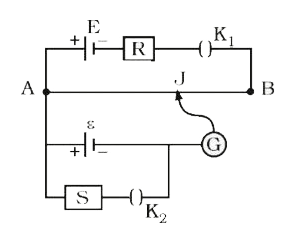
View SolutionTwo students ‘X’ and ‘Y’ perform an experiment on potentiometer separately using the circuit given: Keeping other parameters unchanged, how will the position of the null point be affected it
(i) X’ increases the value of resistance R in the set-up by keeping the key K1 closed and the key K2 open?
(ii) Y’ decreases the value of resistance S in the set-up, while the key K2 remain open and the key K1 closed? Justify.

View Solution
Knowledge Check
The given figure shows five particles are shot from left into a region that contains a uniform electric field. The numbered lines shows the paths taken by the five particles. A negatively charged particle with a charge -3Q follows path 2 while it moves through this field. Do not consider any effects due to gravity.
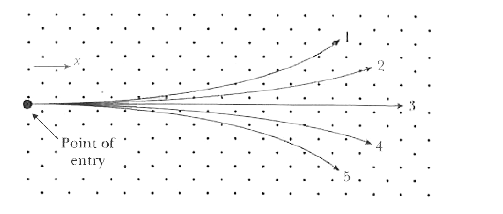
Which path would be followed by a charge + 6Q ?Apath 1Bpath 5Cpath 2Dpath 4The given figure shows five particles are shot from left into a region that contains a uniform electric field. The numbered lines shows the paths taken by the five particles. A negatively charged particle with a charge -3Q follows path 2 while it moves through this field. Do not consider any effects due to gravity.
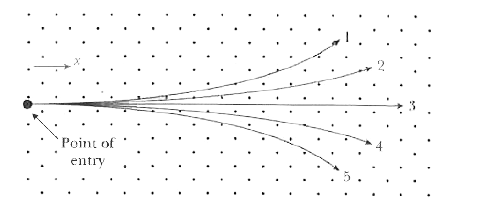
Which path would be followed by a helium atom (an electrically neutral particle) ?Apath 1Bpath 2Cpath 3Dpath 4Read the following passage and answer the questions given after it.
The stark observation made in the Economic Survey of 2015-16 that “Indian agriculture, is in a way, a victim of its own past success – especially the green revolution”, shows the dark reality of the agriculture sector at present and the havoc that has been wreaked by the green revolution.
The green revolution, which is often characterised by the introduction of high-yielding variety of seeds and fertilisers, undoubtedly increased the productivity of land considerably. But the growth in the productivity has been stagnant in recent years, resulting in a significant decline in the income of farmers. There have also been negative environmental effects in the form of depleting water table, emission of greenhouse gases, and the contamination of surface and ground water. Needless to say, the agriculture sector is in a state of distress, which is severely affecting peasants and marginal farmers, and urgent policy interventions are required to protect their interests.
The government has responded to the problem by constituting a panel, which will recommend ways to double the income of farmers by 2022. While this may be an overtly ambitious target, if we want to boost stagnated agricultural growth a shift has to be made from food security of the nation to income security of the farmers. However, there are many hurdles that have to be crossed if we want to achieve this objective.
The first major barrier to overcome is declining productivity. Data from 2013 reveals that India’s average yield of cereal per hectare is far less than that of many countries (including several low income countries), but the difference is huge when compared to China. For instance, our average yield per hectare is 39% below than that of China and for rice this figure is 46%. Even Bangladesh, Vietnam and Indonesia fare better than India in case of rice yield. Further, there is a huge inter-regional variation, the wheat and rice yield from Haryana and Punjab is much higher than from the other states.
In order to cross the declining productivity barrier there is a need to herald a rainbow revolution by making a shift from wheat-rice cycle to other cereals and pulses. Since wheat and rice coupled with other crops are backed by minimum support prices (MSP) and input subsidy (whether water, fertiliser or power) regime, there is a huge incentive for the farmers in the irrigated region of Northwest India to grow these crops.
As per the passage, what is the main cause of decline in the income of farmers?ADepleting water tableBContamination of ground waterCEmission of greenhouse gasesDDecline in agricultural production
The stark observation made in the Economic Survey of 2015-16 that “Indian agriculture, is in a way, a victim of its own past success - especially the green revolution", shows the dark reality of the agriculture sector at present and the havoc that has been wreaked by the green revolution.
>The green revolution, which is often characterised by the introduction of high-yielding variety of seeds and fertilisers, undoubtedly increased the productivity of land considerably. But the growth in the productivity has been stagnant in recent years, resulting in a significant decline in the income of farmers. There have also been negative environmental effects in the form of depleting water table, emission of greenhouse gases, and the contamination of surface and ground water. Needless to say, the agriculture sector is in a state of distress, which is severely affecting peasants and marginal farmers, and urgent policy interventions are required to protect their interests.The government has responded to the problem by constituting a panel, which will recommend ways to double the income of farmers by 2022. While this may be an overtly ambitious target, if we want to boost stagnated agricultural growth a shift has to be made from food security of the nation to income security of the farmers. However, there are many hurdles that have to be crossed if we want to achieve this objective.
The first major barrier to overcome is declining productivity. Data from 2013 reveals that India.s average yield of cereal per hectare is far less than that of many countries (including several low income countries), but the difference is huge when compared to China. For instance, our average yield per hectare is 39% below than that of China and for rice this figure is 46%. Even Bangladesh, Vietnam and Indonesia fare better than India in case of rice yield. Further, there is a huge inter-regional variation, the wheat and rice yield from Haryana and Punjabis much higher than from the other states.
In order to cross the declining productivity barrier there is a need to herald a rainbow revolution by making a shift from wheat-rice cycle to other cereals and pulses. Since wheat and rice coupled with other crops are backed by minimum support prices (MSP) and input subsidy (whether water, fertiliser or power) regime, there is a huge incentive for the farmers in the irrigated region of Northwest India to grow these crops.
As per the passage, what is the main cause of decline in the income of farmers?
View SolutionStudy the following statements and select the incorrect ones.
(i) Pyramids of energy and yearly biomass production can never be inverted, since this would violate the laws of thermodynamics.
(ii) Pyramids of standing crop and numbers can be inverted, since the number of organisms at a time does not indicate the amount of energy flowing through the system.
(iii) There are certain limitations of ecological pyramids such as they do not take into account the same species belonging to two or more trophic levels.
(iv) Saprohytes are not given any place in ecological pyramids even though they play a vital role in the ecosystem.
View SolutionNegative Refractive Index:
One of the most fundamental phenomena in optics is refraction. When a beam of light crosses the interface between two different materials, its path is altered depending on the difference in the refractive indices of the materials. The greater the difference, the greater the refraction of the beam. For all known naturally occurring materials the refractive index assumes only positive values. But does this have to be the case?
In 1967, Soviet physicist Victor Veselago hypothesized that a material with a negative refractive index could exist without violating any of the laws of physics.
Veselago predicted that this remarkable material would exhibit a wide variety of new optical phenomena. However, until recently no one had found such a material and Veselago's ideas had remained untested. Recently, meta-material samples are being tested for negative refractive index. But the experiments show significant losses and this could be an intrinsic property of negative index materials.
Snell's law is satisfied for the material having a negative refractive index, but the direction of the refracted light ray is 'mirror-imaged about the normal to the surface.
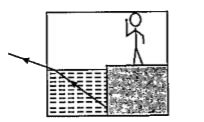
There will be an interesting difference in image formation if a vessel is filled with "negative water" having refractive index - 1.33 instead of regular water having refractive index 1.33.
Say, there is a fish in a vessel filled with negative water. The position of the fish is such that the observer cannot see it due to normal refraction since the refracted ray does not reach to his eye.

But due to negative refraction, he will be able to see it since the refracted ray now reaches his eye.
When the angle of incidence will be equal to angle of refraction for material having negative refraction index?
View SolutionNegative Refractive Index:
One of the most fundamental phenomena in optics is refraction. When a beam of light crosses the interface between two different materials, its path is altered depending on the difference in the refractive indices of the materials. The greater the difference, the greater the refraction of the beam. For all known naturally occurring materials the refractive index assumes only positive values. But does this have to be the case?
In 1967, Soviet physicist Victor Veselago hypothesized that a material with a negative refractive index could exist without violating any of the laws of physics.
Veselago predicted that this remarkable material would exhibit a wide variety of new optical phenomena. However, until recently no one had found such a material and Veselago's ideas had remained untested. Recently, meta-material samples are being tested for negative refractive index. But the experiments show significant losses and this could be an intrinsic property of negative index materials.
Snell's law is satisfied for the material having a negative refractive index, but the direction of the refracted light ray is 'mirror-imaged about the normal to the surface.

There will be an interesting difference in image formation if a vessel is filled with "negative water" having refractive index - 1.33 instead of regular water having refractive index 1.33.
Say, there is a fish in a vessel filled with negative water. The position of the fish is such that the observer cannot see it due to normal refraction since the refracted ray does not reach to his eye.
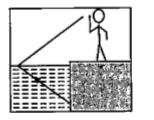
But due to negative refraction, he will be able to see it since the refracted ray now reaches his eye.
Who hypothesized that a material may have negative refractive index?
View SolutionNegative Refractive Index:
One of the most fundamental phenomena in optics is refraction. When a beam of light crosses the interface between two different materials, its path is altered depending on the difference in the refractive indices of the materials. The greater the difference, the greater the refraction of the beam. For all known naturally occurring materials the refractive index assumes only positive values. But does this have to be the case?
In 1967, Soviet physicist Victor Veselago hypothesized that a material with a negative refractive index could exist without violating any of the laws of physics.
Veselago predicted that this remarkable material would exhibit a wide variety of new optical phenomena. However, until recently no one had found such a material and Veselago's ideas had remained untested. Recently, meta-material samples are being tested for negative refractive index. But the experiments show significant losses and this could be an intrinsic property of negative index materials.
Snell's law is satisfied for the material having a negative refractive index, but the direction of the refracted light ray is 'mirror-imaged about the normal to the surface.
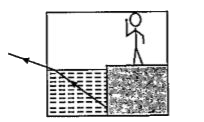
There will be an interesting difference in image formation if a vessel is filled with "negative water" having refractive index - 1.33 instead of regular water having refractive index 1.33.
Say, there is a fish in a vessel filled with negative water. The position of the fish is such that the observer cannot see it due to normal refraction since the refracted ray does not reach to his eye.
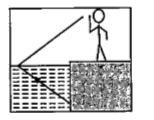
But due to negative refraction, he will be able to see it since the refracted ray now reaches his eye.
Which of the following is the intrinsic property of negative-index materials?
View Solution
